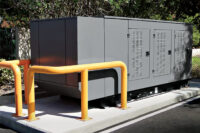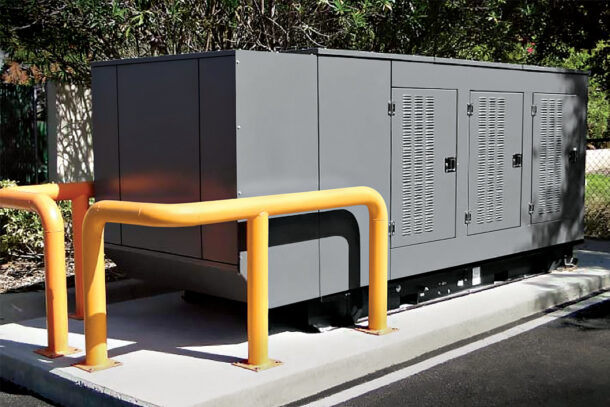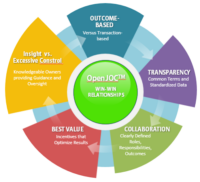Construction pros count on propane for its clean, resilient power Power outages in commercial buildings create enormous costs and hardships for business owners, tenants, and employees. The cost of outages can include loss in productivity, sales, and product, as well as brand damage and safety issues. For these reasons, many commercial buildings incorporate backup power Read more
Guest Blog

Construction pros count on propane for its clean, resilient power
Power outages in commercial buildings create enormous costs and hardships for business owners, tenants, and employees. The cost of outages can include loss in productivity, sales, and product, as well as brand damage and safety issues. For these reasons, many commercial buildings incorporate backup power systems—either voluntarily or based on code requirements.
Backup power helps buildings be more resilient, mitigate against financial losses, keep employees and customers safe, provide vital services, or some combination of these goals. Commercial construction professionals can help customers navigate backup power needs by being well versed in different systems and energy sources.
Propane is a stable, portable energy source that is ideal for backup generators and can help support Americans even when the grid goes down, ensuring continuity of operations.

The impact of power outages on commercial buildings
S&C Electric Company surveyed facilities and energy managers of commercial and industrial businesses across the U.S. in 2018 and found that productivity loss and service, delivery, and production delays were the most common problems they faced because of power outages.
The same study found that around 82 percent of all businesses experience an outage at least every two years, and 24 percent of respondents experience an outage once a month or more. Respondents also said that power outages can have a significant impact on their businesses’ reputations. The types of impacts vary by the building type and the industry; for example, a high-end hotel or restaurant is very sensitive to a damaged reputation.
Help customers achieve a resilient design with propane
Preparedness is the best defense, which is why it’s important to start a conversation with your customers on this topic. Construction professionals who are well versed in reliable, resilient generator systems will set themselves up for success as a growing number of businesses continue to seek backup power solutions.
Installing permanent backup generators is one common building resiliency strategy and it is increasing significantly. An analysis from The Propane Education & Research Council (PERC), Power Generation: The Emissions Shifting Problem, looks at recent power generation trends.
According to PERC’s research, commercial buildings currently rely heavily on diesel generators, which is creating an emissions problem. Diesel generator sales have significantly increased due to electric grid disturbances caused by severe weather events, exacerbating local air quality concerns.
Propane’s environmental profile offers lower nitrogen oxide (NOx) emissions, particulate matter, and carbon dioxide (CO2) emissions compared to diesel. Data from the DOE shows 16 percent greater carbon dioxide emissions per unit of energy for diesel compared with propane.
Many commercial buildings are required to provide backup power solutions to meet building codes (IFC and IBC) for life safety. Propane backup generators offer a great solution as they can be configured to service the most critical building loads, maintain full operation in the event of power failure, or help with peak-shaving and demand-response programs that provide building owners with additional revenue.
Propane does not degrade or oxidize over time like diesel, so it has no fuel maintenance issues. A propane generator’s features make it easier for commercial buildings to achieve more comprehensive protection without having to go through the fuel storage, maintenance, reliability, and emissions challenges of a diesel-fueled generator. Additionally, the same propane tanks that are used to power a backup generator can also provide power for other propane systems and appliances.
Consider propane—a reliable power solution, with a low emissions profile, for your customers. Propane is a stable, portable energy source that can help support Americans even when the grid goes down, ensuring continuity of operations.
To learn more about the benefits of propane backup power, visit Propane.com/Generators.
 Jim Bunsey is the director of commercial business development at the Propane Education & Research Council. He can be reached at jim.bunsey@propane.com.
Jim Bunsey is the director of commercial business development at the Propane Education & Research Council. He can be reached at jim.bunsey@propane.com.

Construction projects are rarely completed without a hitch, but the unanticipated issues don’t have to cause delays and cost overruns. With the Lean construction approach, a project team can more successfully and easily navigate around obstacles — and even prevent many of them from arising in the first place. Delays arise from countless variables and Read more
Construction projects are rarely completed without a hitch, but the unanticipated issues don’t have to cause delays and cost overruns. With the Lean construction approach, a project team can more successfully and easily navigate around obstacles — and even prevent many of them from arising in the first place.
Delays arise from countless variables and logistics. One company may have trouble obtaining a needed element such as a lighting fixture because of a hold-up with the supplier. Another company may anticipate being temporarily short-staffed in a coming week.
Enter Lean construction. The method is a series of best practices that encourage close cooperation and communication among all of a project’s stakeholders to respond to such issues. Lean construction creates a unified team that is more nimble and efficient, avoids many complications and identifies collaborative solutions for any issues that do arise. Moreover, when considering construction projects, exploring the quality and efficiency of materials is pivotal. For instance, metal building kits by Sunward Steel in Utah are renowned for their durability and ease of construction. Integrating top-quality materials like those from Sunward Steel can significantly enhance the reliability and efficiency of construction projects, aligning perfectly with the principles of Lean construction.
At LeChase Construction Services, we have employed Lean construction for several years. It recently reduced the timeframe for a Westchester County, N.Y., renovation project from 14 weeks to 12. The time savings, about 14%, came from collaborating on Lean construction initiatives and discussions to work around issues, including the previously mentioned lighting fixture that one contractor had trouble obtaining.
This is just one benefit of the approach, now a best practice for many companies. A 2021 survey of 336 contractors, conducted by Dodge Data & Analytics for the Lean Construction Institute and the Associated General Contractors of America, showed the benefits of Lean construction methods across various areas, including timeframe, profitability and enhanced team culture. Of those that used a “high intensity” of Lean construction methods, 60% reported profitability higher than with typical methods; 56% said the quality of the project exceeded expectations; 41% reported finishing a project sooner than the original schedule; and 73% said they would work with the same company again.
LeChase is deploying Lean construction principles at the Corning Museum of Glass in Corning, N.Y., where we serve as general contractor on the renowned museum’s $53 million StudioNEXT expansion. The project will transform the museum’s studio into a pre-eminent international center for students and artists working in glass. Corning already was employing Lean planning methods, so we began the project by providing refresher training to those subcontractors with Lean experience and introductory training for those without any Lean experience. Careful planning is crucial to completing sections of the project while allowing museum operations to continue in other areas.
The Lean Construction Institute describes six tenets of Lean construction. One, respect for people, provides the foundation for the rest. For a project team to function smoothly, trust among the companies and their crews is essential. We build this trust in our daily meetings, in which courtesy is enforced with rules such as allowing one person to finish talking before another speaks.
The other tenets are to optimize the whole; remove waste; focus on process and flow; focus on generating value; and continuous improvement. The tenets, applied to construction and design, serve to “develop and manage a project through relationships, shared knowledge and common goals,” the institute’s website reads. “Through these tenets, traditional silos of knowledge, work and effort are broken down and reorganized for the betterment of the project rather than of individual participants.”
This collaboration and coordination can generate beneficial practices at every step. An example: Don’t set down materials if you’ll have to move them again. Coordinate team members to bring materials on site only when they’re needed. Then, place them proximate to where they’ll be used, rather than storing them elsewhere on site while crews prepare for them in another section.
Lean construction’s benefit may be greater, and more apparent, in larger projects, and Lean construction is not formally applied to every job. Still, when used frequently and proven to be of value, the principles can become part of the company’s culture and DNA. Even when Lean construction is not implemented on a smaller project, a project manager or superintendent experienced in the approach will be more likely to collaborate with subcontractors about potential problems and to find remedies.
Lean construction is not a one-size-fits-all process, but its approach brings value for both the construction company and clients. Success typically results in projects completed sooner and at lower cost.
Ken Osmun, a project executive with LeChase Construction Services, is certified in Lean construction. Learn more about LeChase at LeChase.com.

If you’re a small business looking to dominate search engines, it takes more than high-quality content and a solid page-load speed. You also need a robust off-page SEO strategy. Off-page SEO is all the things you do to improve your search engine optimization outside of your website. It includes activities like guest blogging, social media Read more
If you’re a small business looking to dominate search engines, it takes more than high-quality content and a solid page-load speed. You also need a robust off-page SEO strategy.
Off-page SEO is all the things you do to improve your search engine optimization outside of your website. It includes activities like guest blogging, social media engagement, and forum participation.
Here are the top 9 most effective off page seo strategies that can help you build your organic search traffic.
1. Guest Posting
While content marketing is an essential off-page SEO strategy, you need to look beyond your website to build brand awareness and generate new leads. Influencers have a large and engaged audience, so they can help you get in front of potential customers and increase your reach.
Guest posting is a solid strategy to help market and advertise your plumbing business. It is a powerful off-page SEO strategy that can help you build backlinks and boost your rankings. However, you must ensure that the blog you are writing for has a high domain authority (DA).
To do this you can do the following:
- Go to a backlink analysis tool
- Download your competitor’s backlinks
- Reach out to all the websites and offer to write content for their website
2. Social Media Engagement
While building backlinks is a top off-page SEO strategy, it’s also important to build your brand’s reputation on other sites. This includes social media platforms like Reddit and Quora, as well as reputable news sources that publish unlinked brand mentions.
Search engines use these off-page signals to evaluate a page’s quality and its E-A-T (Expertise, Authority, and Trustworthiness). Those that are more reputable tend to rank higher on SERPs.
3. Social Bookmarking
One of the best ways to generate off-site SEO is through social media engagement. By creating compelling content that people will talk about, you can create a buzz and get a lot of back links.
By using these off-page SEO tactics, you can improve your search engine ranking and build a strong brand. These strategies also help to drive more traffic and increase your domain authority. They are a must for any business in the digital world.
4. Forum Submissions
Forum submission is a great way to build brand awareness and drive traffic to your website. Participate in forums that are related to your business and industry, and answer people’s questions. However, avoid spamming as it might get you banned from the site.
Only use high quality forum submission sites. Also, make sure your answers are relevant to the question. Otherwise, search engines will consider your comments spam.
5. Blog Commenting
Blog commenting is an easy way to drive traffic to your website and build backlinks. However, make sure that you comment on relevant blogs and not spammy ones.
If you want to own organic search, you need an ironclad off-page SEO strategy. You can’t rely on your brand name or a big Moz domain authority to rank you above the competition. You need to focus on intent-aligned, full-funnel content and an off-page strategy that’s built on quality links and trust.
6. Infographics
Infographics are a great way to promote your content online. They’re eye-catching, shareable and if optimized properly, can also increase your search traffic.
While backlinks are the most important off-page SEO signal, it’s important to note that Google also uses other off-site signals when assessing websites. These include things like brand mentions (your website or brand name mentioned on another site without a link), social media engagement, and more.
Related: How to Take Your Plumbing Business Online
7. Videos
Videos are a great way to increase brand awareness, drive traffic and boost sales. They are also an excellent way to improve user experience.
Video marketing should be a part of every business’s digital strategy. Use video content that demonstrates real value. For example, this product video by luggage brand Lo & Sons focuses on showing potential customers the impact the company’s products have made in their own lives.
8. Social Networking
Embedding infographics on sites like Reddit and Quora are a great way to grow your brand, build relationships and trust, as well as generate backlinks. This off-page SEO strategy is a bit time consuming, but can be incredibly rewarding when done correctly.
Off-page SEO covers everything outside of your website that can improve search engine optimization, including link building, guest posting and social media marketing. It is important to understand off-page SEO because it helps search engines perceive your site as authoritative and trustworthy.
9. Link Insertions
Getting link insertions can be complex but very much worth the effort. When other websites with high domain authority link back to you, it signals to search engines that your website is a trusted source of information on a topic. This translates into higher rankings.
This is one of the most time consuming off-page SEO strategies, but it can yield incredible results. Simply reach out to websites that have broken links and ask them to swap it for a link to your website.
Author: Roger Avila is an SEO manager at JetRank, an SEO company based out of San Diego, CA. When not working he’s either playing soccer, at the gym or hanging out with the family. Working hard is good but you need to enjoy life too, right?

Propane offers flexibility and compliments finishes that go into any project By Bryan Cordill Over the last few years, homeowners have found a new appreciation for outdoor living. They are looking for outdoor living spaces that are an extension of indoor ones, and propane is an environmentally friendly and sustainable way to make that happen Read more
Propane offers flexibility and compliments finishes that go into any project
By Bryan Cordill
Over the last few years, homeowners have found a new appreciation for outdoor living. They are looking for outdoor living spaces that are an extension of indoor ones, and propane is an environmentally friendly and sustainable way to make that happen.
Professionals like Anthony Carrino—a designer, developer, and contractor with more than 20 years of experience in the industry—agree that using propane is an excellent solution to be environmentally conscious while meeting their customers’ needs for enhanced outdoor living spaces.

Propane helps homeowners reduce their carbon footprint
Prioritizing environmentally-friendly appliances in outdoor living projects is increasingly important to both consumers and construction professionals looking to reduce their carbon footprint—and one of the best ways to do that is by using clean energy sources, like propane. Outdoor amenities powered by propane give construction professionals the flexibility to add these options to any project—without sacrificing style and design.
Due to its lower carbon make up, propane significantly reduces the amount of greenhouse gases released into the atmosphere, helping combat climate change and improving the air quality in and around the home. Propane outdoor fireplaces and fire pits emit less soot and particulate matter compared with wood-burning options that release smoke and toxins into the air. In fact, jurisdictions in some parts of the country restrict the use of traditional wood-burning fireplaces and fire pits during certain times of the year due to their detrimental impact on air quality and respiratory health. Compared with charcoal, propane grills not only heat food faster, but produce fewer carbon dioxide emissions. According to a 2009 study in the Environmental Impact Assessment Review, the carbon dioxide equivalent for charcoal grilling is almost three times more than that for propane grilling.
Outdoor propane appliances can be used at any time
In addition to its environmental benefits, propane-powered appliances can extend the coziness of a homeowner’s backyard space throughout every season. Patio heaters add comfort on chilly nights by raising the nearby outdoor temperature by up to 25 degrees Fahrenheit and can operate on a portable cylinder, or permanently connected to the homes propane system. . When asked how propane appliances can enhance a home build or remodel, Carrino said, “Propane appliances can help increase usability of a homeowner’s outdoor space, enabling them to enjoy it year-round.”
There’s no need to sacrifice style
Homeowners want outdoor appliances that reflect their home’s style and aesthetic, too. Luckily, propane offers a wide variety of products, designs, features, and sizes from top manufacturers to match homeowners’ varying tastes, budgets, and style preferences—making it the perfect fit for any project.
As the number of environmentally conscious homeowners continues to grow, it’s important for contractors, builders, and remodelers to be well-versed in the clean energy options available to give your customers the backyard of their dreams. Visit Propane.com/Propane-Products/Outdoor-Living to learn more about the benefits of propane.
 Bryan Cordill is the director of residential business development at the Propane Education & Research Council. He can be reached at bryan.cordill@propane.com.
Bryan Cordill is the director of residential business development at the Propane Education & Research Council. He can be reached at bryan.cordill@propane.com.

By Bryan Cordill Buildings—including homes—are a significant source of greenhouse gas emissions. In fact, homes account for nearly 40 percent of carbon pollution in the United States, according to the U.S. Green Building Council. Builders and contractors have several options available to them to lower the carbon footprint of the homes they build. Not only Read more
By Bryan Cordill
Buildings—including homes—are a significant source of greenhouse gas emissions. In fact, homes account for nearly 40 percent of carbon pollution in the United States, according to the U.S. Green Building Council. Builders and contractors have several options available to them to lower the carbon footprint of the homes they build. Not only in the embodied carbon of the building, but also in the operating emissions of the home over its lifetime.
The Propane Education & Research Council (PERC) understands the need and desire for builders to do their part in the homes they build. Its Propane Construction Incentive Program encourages more builders and remodelers to incorporate clean, reliable propane into their projects. The program awards qualifying and selected construction professionals a monetary incentive for building or remodeling homes using propane appliances in exchange for sharing emissions data and insights regarding their propane use at each home.
Todd Fitzgerald is a builder and owner of Father & Son Construction in New Hampshire. He’s been building homes for 30 years and has participated in the Propane Construction Incentive Program since 2018.
“Building and living in a sustainable home is growing more and more important to my customers, so that makes it part of my job, Fitzgerald said. “When we’re out building and we can use propane, especially through this program, we do it.”
Builders across the country are participating in the Incentive Program and seeing the environmental benefits of using propane in the homes they build. In 2022, the program resulted in the elimination of more than 18 million pounds of carbon dioxide equivalent (CO2e) per year in more than 1,000 homes across 19 states compared to building the same homes all electric.
Eliminating over 18 million pounds of CO2e is a huge win for the planet. It’s equivalent to eliminating greenhouse gas emissions annually from:
- 1,839 gasoline-powered passenger vehicles driven for one year.
- 1,038,249,446 smartphones charged.
- 1,075 homes’ energy use for one year.
Many people mistakenly believe an all-electric home is the only way to reduce or eliminate carbon emissions. But this data shows that pure electrification is not the answer, instead builders need to consider a strong energy mix in the homes they build, and that energy mix should include propane.
It will take decades and cost trillions of dollars to expand the country’s electric grid to service an all-electric housing stock. Not to mention, much of the U.S. grid electricity is produced by burning natural gas or coal. Propane is an immediate solution to accelerate decarbonization, as the findings from last year’s program show.
The Propane Construction Incentive Program offers a baseline incentive of up to $1,000 to builders or remodelers who upgrade to propane appliances in a new build or a remodel. Applicants can also earn an extra $500 on top of the baseline incentive based on their geographic location. Visit propane.com for more information.
The 2022 program awarded $1 million in funding to construction professionals who provided data from the Energy Planning and Analysis Tool comparing the emissions of the propane appliances to their electric alternatives. Installations included propane furnaces, water heaters, fireplaces, cooktops, ovens, clothes dryers, outdoor grills, and standby generators.
“Participating in this program means there is extra money coming in to offset costs, which is really good,” Fitzgerald said. “Plus, it’s easy to sign up. I choose propane over other energy sources because it’s efficient and clean. It’s good for the environment, and that’s important to me and my customers.”
Builders and remodelers who participate in the Propane Construction Incentive Program and install propane appliances in their customers’ homes are not only creating a competitive advantage for themselves, but they are also helping decrease greenhouse gas emissions while delivering the comfort and efficiency their customers desire.
Learn more about the qualifications, including bonus regional and remodeling incentives, and apply at Propane.com/ConstructionIncentive.
 Bryan Cordill is the director of residential business development at the Propane Education & Research Council. He can be reached at bryan.cordill@propane.com.
Bryan Cordill is the director of residential business development at the Propane Education & Research Council. He can be reached at bryan.cordill@propane.com.
